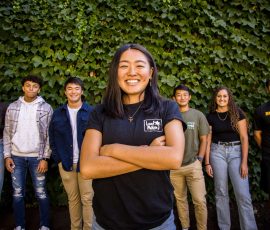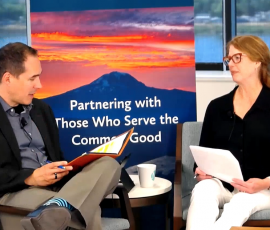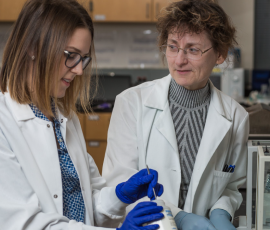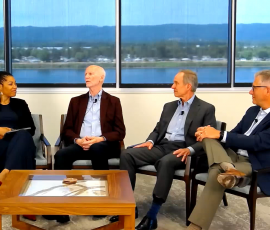In June, we were pleased to gather our CEO, Romanita Hairston, and our three Trustees, John Castles, Jeff Grubb, and Jeff Pinneo, for a conversation reflecting on our founder, Jack Murdock, and his legacy at the Trust and in our region. This was one of seven sessions for our virtual Founder’s Day celebration where we got to hear about each area of the Trust’s work, learn more about recent organizational shifts, and hear from leadership.
Because we were not able to address all audience questions live, we wanted to follow up with Romanita Hairston and respond to those we missed. Read Romanita’s answers below, and scroll down for the session recording with timestamps of the conversation.
Q&As
These were questions registrants submitted before the session, or that attendees submitted during the session, that we didn’t have time to answer live. We appreciate your curiosity, and were pleased to follow up with our CEO, Romanita Hairston, to answer some of these questions.
What project are you most proud of, and what would you like to improve on?
Speaking as CEO, I must honestly say that I am most proud of the way we have stewarded Jack Murdock’s legacy through our ongoing support of nonprofits and focus on the common good. I am grateful for the ways we have kept improving the experience of those we serve. Specific projects like new systems development and integration, behind-the-scenes restructuring, and updates to our guidelines are important. Their significance is the way they directly impact nonprofits’ time spent on their grants and in our programs as well as the experience of engagement and partnership with our team. It is our privilege to be part of this work that has guided the Trust for nearly five decades now. We are grateful to partner with nonprofits in achieving their missions, working toward a Pacific Northwest where everyone can flourish.
In terms of specific projects, one area that we recognized needed improvement to better serve our constituents was our grants application process. The Trust has always been committed to evolving our processes to fit the current landscape and constituent needs. At one point, this meant going from paper applications to an online portal. This year, it meant streamlining our application process and making revisions based on grantee and applicant feedback. I am so proud of my team and grateful to all constituents who spoke into the process. While we are still early in the process, I’m pleased to say that we are hearing application times are down quite a bit . We’ve also been able to significantly reduce our backlog and achieve a review time that better meets the needs of applicants, delivering responses to proposals more quickly. Because this is a new release, we will continue to iterate on it and find opportunities for continuous improvement. You can learn more about this process in our Project Phoenix Fireside Chat session at Founder’s Day 2024.
What, if any, new trends are you seeing with grantees with regards to challenges / opportunities they are facing in achieving their missions? How is the Trust thinking about addressing these with its support and focus?
One challenge we hear from grantees is the ability to retain staff and to manage the incredibly high turnover in the nonprofit sector. To that end, we have programs that help strengthen nonprofit leadership skills so that executive directors, development directors, and board members feel more equipped to do their roles well in service of their mission, which tends to lead to longer tenures in those positions. We also have specific grant initiatives to support new science faculty at undergraduate institutions so they have a strong start to their career at that school, which reduces turnover rates. These are just some ways our current grants and programs address this need, but it is one that we continue to pay attention to and ask questions about. We recognize that there are other systemic issues related to the financial models around both pay and funding cycles alongside the intensity of the work in many areas that can contribute to burnout. In the cases where we don’t have programs, we stand alongside other partners who are doing good work in these areas.
We are also hearing that nonprofit organizations are wrestling with appropriate ways to adopt and implement new technologies to maximize their impact. We are investing time and energy to understand the specific needs of nonprofits to digitally transform, as well as the latest evolutions in tools like AI and how they can be best applied to strengthen our region’s nonprofit sector. We hope to do more in this space as we listen and learn how we can make our best contribution.
Where did Jack’s love of aviation stem from?
Bruce Murdock, Jack’s second cousin, shared in “The Jack Murdock Story” that he thinks it was “spiritual solace” that Jack sought in a plane. We know that Jack was a humble, even shy man, happy in solitary situations. I can imagine that the freedom of flying, the solitude of the activity, and the vantage point from which he could look over the region he loved were just a few reasons he loved to fly.
When thinking about Jack’s perspective on [organizational] sustainability, what were his key strategies? What tactics did he employ to ensure the sustainability of his businesses and how does that translate to nonprofit organizations now?
Jack Murdock cared deeply about his employees because he recognized that strong companies start and end with strong teams and staff. He saw his employees as whole people, with families, interests, hobbies, and needs. He was one of the first to introduce employee-focused offerings at Tektronix, including flexible hours and a flat, open-door leadership structure. He was also an innovator in employee care. He was known to encourage people to bring their families to work events. He supported employee mental health and work-life balance. To me, this is one of the strongest sustainability strategies there is, because when employees are invested in the work and given healthy workplace conditions, their efforts will be higher and their work more meaningful to them. I like to think that Jack recognized the importance of connecting employee passion to the purpose of the company or organization.
Today, nonprofits are facing incredible staff turnover and burnout alongside many intractable challenges, which is a barrier to sustainable growth. I think Jack’s example is a potent one here. At the same time, nonprofits do not always have the resources or capacity to care for their staff the way they might wish to, which is why the Trust funds projects that build capacity, in order to help make that possible. In the past, we have also run a Staff Care and Wellbeing Initiative, which funded intentional team-building and wellbeing grants for nonprofit staff.
When you talk about the Pacific Northwest and beyond, what is the likelihood of future decisions to offer grants and make an impact in regions outside the Pacific Northwest and what would feed into those decisions?
The three original Trustees Jack appointed to steward his resources established the Trust’s geographic footprint following his untimely death. They decided to focus funding on the five states of the Pacific Northwest – Alaska, Montana, Idaho, Oregon, and Washington – because those are the states that were dear to Jack Murdock’s heart and that Jack served through his Piper Cub Distributorship. Our Trustees have considered the geographic footprint during times of growth. While the Trust has remained committed and centrally focused on the Pacific Northwest region, we also fund the Cascadia region, which includes Vancouver, B.C. Additionally, we do occasionally fund groups that approach work from a national perspective that have distinctive work in areas of the Trust interest. We strive to remain open to new ideas and possibilities as an organization.
What resources are there for organizations to improve their understanding and capacity in partnership with the Murdock Trust?
All resources regarding grantmaking and programs are available on our website, murdocktrust.org. We want you to have all the information you would need upfront to know if you are eligible to apply for a Trust grant or program, so we put a lot of information there. Some places to start: Grant Opportunities; Programming; News & Announcements.
Watch the full recording and find the topics that interest you most using the timestamps below.
The Conversation
00:25: Where we’ve been and where we are now (Romanita Hairston)
03:10: What’s ahead for the Murdock Trust (Romanita Hairston)
05:39: Introducing our three Trustees
06:18: How the vision of the Trust reflects Jack Murdock’s legacy (John Castles, Jeff Grubb)
11:38: The Trust’s priorities in navigating recent transitions (Jeff Pinneo)
16:46: Hopes for the next 50 years of the Murdock Trust (John Castles, Jeff Grubb, Jeff Pinneo, Romanita Hairston)
25:18: Audience Q&A: Who Jack was as a person (John Castles, Jeff Grubb, Jeff Pinneo, Romanita Hairston)
30:29: Jack’s mental health advocacy and employee care at Tektronix (Jeff Grubb, John Castles, Jeff Pinneo)
33:10: Audience Q&A: How we support established versus emerging nonprofits (Jeff Grubb, Romanita Hairston)
35:59: Audience Q&A: Learnings coming out of COVID (Romanita Hairston, Jeff Pinneo, Jeff Grubb, John Castles)
42:15: Audience Q&A: What we’re excited about for the future (Romanita Hairston, Jeff Grubb, Jeff Pinneo, John Castles)








